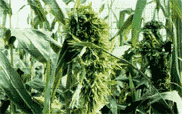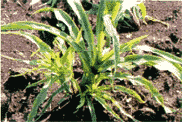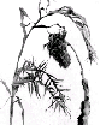Reports on Plant Diseases |
RPD No. 207 - Crazy Top of Corn
|
May 1988
|
[ Symptoms ] [ Disease
Development ] [ Control ]
Crazy top with abnormal tassel. (Courtesy D.G. White) Crazy
top of corn, caused by the fungus Scleroph thora macrospora (Sclerospora
macrospora), has occurred widely but sporadically in Illinois.
The disease is seldom prevalent enough to cause much damage, although
losses of at least 60 percent in grain yields have been reported
in parts of some fields. Crazy top, when it does occur, is invariably
found in localized areas of fields and gardens where the soil becomes
waterlogged or flooded between the time the corn kernels germinate
and the seedlings are 6 to 10 inches tall.
The causal fungus attacks all types of corn and more than 140
species of wild and cultivated grasses. The disease hosts include
oats, rice, sorghums, wheats, crabgrasses, witchgrasses, foxtails,
and barnyardgrass. The fungus is incapable of developing in the
absence of a host plant and must reinfect living corn or grass
plants each season. In the absence of corn, the crazy top fungus
maintains itself on wild grasses.
|

Figure 1. Crazy top with abnormal tassel. (Courtesy
D.G. White)

Figure 2. Crazy top and tillering. (Courtesy D.G.
White)
|
Symptoms
The symptoms vary greatly according to the time of infection
and the degree of host colonization by the fungus. The most conspicuous
symptom is the partial or complete replacement of the normal tassel
by a large, bushy mass of small leaves (Figures 1-3). These modified
leaflike inflorescences are described as “crazy top.” No pollen
is produced, since normal flower parts in the tassel are completely
deformed. Ear formation may also be checked, causing the ear shoots
to be numerous, elongated, leafy, and barren (Figure 3). Plants
affected by crazy top vary greatly in height. Some may be severely
stunted, with narrow leaves that are strap-like, leathery, yellow
to brown, and streaked, and with 6 to 10 tillers per plant (Figure
2). Generally, excessive tillering, rolling, and twisting of the
upper leaves appear first. Other plants may be taller than average,
with additional nodes and leaves above the ear and in the shank
(Figure3). The principal effect, however, is the development of
the tassel and ears into leafy tissues. Common corn smut frequently
occurs on these abnormal leafy growths.
|
|
The Sclerophthora fungus overseasons in diseased corn or grass
residue
as microscopic roundish oospores that are thick-walled and colorless
to
yellowish. The numerous oospores presumably germinate in soil that
is
saturated for 24 to 48 hours, forming a thin-walled tube that bears
a
lemon-shaped sporangium. The sporangium, in turn, germinates to
produce numerous motile zoospores. After swimming about in the
soil
water for a short time, the zoospores encyst and produce a germ
tube that
penetrates seedling host tissue sometime during the period from
shortly
after sowing to before the plants are in the 4- to 5-leaf stage.
Following
infection, the fungus develops systemically and invades the entire
corn
plants, being most abundant in meristematic tissues.
Infection occurs over a wide range of soil temperatures. The
optimum for
sporangial germination is 53° to 63°F (12° to 16°C).
Seed transmission
of the Sclerophthora fungus has been demonstrated but is generally
considered unimportant in the dissemination of the fungus.
|

Figure 3. Crazy top of corn
excessive number of nodes and
leaves on upper half; a bunch of
leafy growth in place of the tassel
flowers on lower area.
|
|
Crazy top is seldom important enough to warrant special control
measures. However, the following steps may be taken:
- Provide adequate soil drainage.
- Control grassy weeds.
- Do not plant corn in low, wet spots.
Very little is known about the relative resistance of inbred lines
of corn and of hybrids to this disease. Seed treatment has no effect.
|
Back to Top
For further information concerning diseases of crucifers
and other vegetables, contact Mohammad Babadoost, Extension Specialist
in Fruit and Vegetable Diseases, Department of Crop Sciences, University
of Illinois at Urbana-Champaign.
University of Illinois Extension provides
equal opportunities in programs and employment.
|



